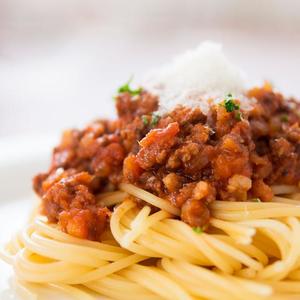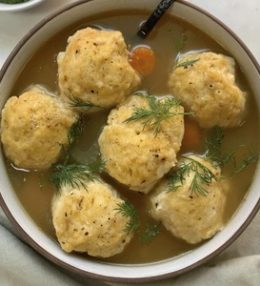
By using some science and a bit of elbow grease, my Spaghetti and Meat Sauce recipe gets the most flavor out of the ingredients in the least amount of time.
Recipe
Video
Pin

Spaghetti From Scratch
Spaghetti with Meat Sauce is one of those classic global comfort foods that moms around the world make for their kids. Pasta and sauce has a myriad of variations, whether it’s Spaghetti Napolitan in Japan, Macaroni and Cheese in the US, or this Italian-American classic, it’s always a favorite family meal. Although the sauce and pasta have roots in Italy, it didn’t come together as a dish until Italians started migrating to other parts of the world.
These days, people are busy, and I get the temptation to use the pre-made stuff from a jar, but making it from scratch doesn’t take that much more work, and homemade spaghetti sauce tastes so good that it’s worth the small extra effort. Meat sauce also freezes well, so if you’re really pressed for time, you can make a big batch of this on the weekend, portion it, then just pull it out of the freezer, reheat, and toss with freshly boiled spaghetti on a weeknight.
Why This Recipe Works
- By physically cutting the aromatics into smaller pieces and adding some baking soda to raise the pH, we’re able to caramelize them much faster than normal. This infuses the sauce with a balancing natural sweetness, and tons of flavor that most quick sauces won’t have.
- Using a combination of ground pork and beef creates a more complex flavor profile, making the sauce taste like it’s been simmered for hours.
- Cooking the meat in red wine (rather than sauteeing it) keeps it tender, so you don’t have to cook it for long.
- In addition to the puréed tomatoes, I also like to add a small amount of ketchup. There are three very good reasons to do this. The first is that ketchup has a concentrated tomato flavor, which makes the sauce taste like it’s been cooking for much longer. The second is that ketchup is sweet, so by adding a small amount, it’s not enough to make the sauce overly sweet, but it helps balance the acidity of the tomatoes and wine. Finally, ketchup includes spices like nutmeg and cloves, which are often added to more complex meat sauce recipes. By adding the ketchup, you get the nuances of these spices without having to add the spices themselves.
- Simmering the sauce at a higher temperature while stirring it evaporates the excess moisture quickly, which allows you to reduce the sauce down to a nice thick consistency without cooking it for hours.

What are the ingredients for Meat Sauce?
Broadly speaking, spaghetti sauce has three main components, the aromatics, the meat, and the liquids.
Meat
- Ground Beef – Meat sauce gets most of its flavor from the ground beef, so I like adding a relatively high ratio of lean ground beef. If I have the time, I like to grind my own beef, so I know exactly what’s in it, and it also allows me to grind it coarsely, which gives the sauce a better texture.
- Ground Pork – I like to add a bit of ground pork, which adds savory umami to the sauce. Ground lamb, chopped bacon, or Italian sausage are other good alternatives.
Aromatics (a.k.a. Sofrito)
- Garlic – Garlic makes almost anything better, and I like adding lots of minced garlic cloves to my sauce.
- Onions – Onions add flavor and mild sweetness, but it’s important to caramelize them to get the most flavor out of them. One of the tricks to doing this quickly is to mince them as small as possible.
- Carrots – Carrots are a traditional part of sofrito, but they need to be cooked for a long time to dissolve into the sauce. By grating them, this not only speeds up the time it takes to caramelize them, but it also allows them to dissolve seamlessly into the sauce in minutes instead of hours.
Liquids
- Red Wine – Although white wine will work, I like using red wine because it gives the sauce a deeper color and flavor, which makes it seem like the sauce was cooked for much longer.
- Tomato Puree – Although I use whole canned tomatoes for my slow-cooked Bolognese, I like using pureed tomatoes for this because it reduces the cooking time as the tomatoes are already broken down. You can substitute whole stewed tomatoes if you like, but I recommend mashing them up a bit first before you add them. I do NOT recommend using diced tomatoes, as these have been picked before they’re fully ripe so that they can maintain their shape after being diced and canned. Tomato sauce doesn’t have as much tomato flavor as tomato puree, and tomato paste lacks the freshness that puree provides.
- Ketchup – A small amount balances out the acidity of the wine and tomatoes while adding a concentrated tomato flavor and spices.
Spices
- Oregano – The classic Italian herb for a homemade spaghetti sauce recipe, oregano provides an herbaceous note to the sauce.
- Black Pepper – Provides heat and floral notes, and pairs well with the meats and wine.
- Other Spices – I’ve kept this recipe pretty classic and simple, but if you want to kick it up a notch, red pepper flakes, dried basil, or even my Umami Seasoning Salt would make great additions.
How to Make Spaghetti With Meat Sauce
The Spaghetti
Water takes a while to boil, so I always start by putting a large pot of salted water on to boil. I usually add 1 tablespoon of table salt for every gallon of water. This ensures each strand of pasta is well seasoned.

Any kind of spaghetti will work, but spaghetti noodles come in thicknesses ranging from 1.4mm to 2.2mm thick. While any thickness will work for this pasta recipe, thicker noodles take longer to cook, while thinner noodles will take less time, so check the package to figure out the right amount of time to boil the pasta. I usually boil it for 1 minute less than what the package says and then finish cooking it in the sauce.
The Sauce
The first step to making any great sauce is to caramelize the aromatics. This is a process that can normally take up to an hour to do properly, but by cutting the aromatics small, adding some baking soda, and steaming them covered with a lid, we can reduce this down to around 13 minutes.
Amongst its many superpowers, baking soda has the ability to break down the aromatics, which makes them cook faster and eventually dissolve into the sauce as if they’d been cooked for hours. It also raises the pH of the mixture, which speeds up both caramelization and the Maillard reaction. Both of these browning reactions lead to the creation of new flavor compounds, which take pungent, spicy onions and turn them into mellow, sweet flavor bombs.

Once the garlic, onions, carrots, baking soda, and olive oil mixed together in a pan, I cover it with a lid before turning on the heat. This traps the steam escaping from the vegetables. Since water vapor is much more efficient than air at transferring heat to the aromatics, it makes them cook through much faster.

After about 10 minutes of steaming, you can remove the lid and boil off any remaining liquid, while allowing the aromatics to caramelize in a matter of minutes.

Then, I add the beef and pork and crumble them up a bit with a spatula before adding the wine. You want to add the wine to the meat before it’s fully cooked as the liquid keeps the ground meat from getting tough (which would require a lot of time to tenderize).

Finally, the tomato puree, ketchup, oregano, salt, and pepper get added, and I cook this together over medium heat to get it to reduce quickly. You should be able to get the sauce to the right consistency in under 10 minutes. Still, it’s important to stir it continuously, which not only prevents the sauce from burning, it also speeds up the evaporation of excess liquid. You can tell when the sauce is done when you can scrape a spatula along the bottom of the pan, and the sauce takes a moment to fill in the gap.

Put them Together
This is perhaps the most important step because it marries the two components of this dish together. Once your meat sauce is nice and thick and your pasta is about a minute from being fully cooked, transfer the spaghetti straight into the pan with the sauce using tongs. Don’t worry about the starchy pasta water that hitches a ride because this extra liquid allows you to finish cooking the pasta in the sauce. If your spaghetti starts to clump up, just add more pasta water 1 ladleful at a time as you mix. When the pasta is cooked to your liking, and each strand is coated in a glistening layer of meat sauce, it’s done! At this point you can serve it or you can grate in your favorite dry cheese such as Parmigiano-Reggiano (a.k.a. Parmesan), or Pecorino Romano and stir it in.
What’s the history of Spaghetti with Meat Sauce?
Like most things in food lore, it’s unclear exactly where Spaghetti with Meat Sauce was created, but one thing that is certain is that it did not originate in Italy. One theory suggests that it was created in the US about 100 years ago when there was a large influx of Italian immigrants. Between 1880 and 1924, more than four million Italians emigrated to the US, many of them from the south of Italy. This is an important clue because although Meat Sauce is often called “Bolognese” (named after a city in the north), the preparation and ingredients are actually closer to a Neapolitan ragù, which comes from the southern city of Naples (which is also where pizza was born).
What’s the difference between Meat Sauce and Bolognese?
Although the two terms are often used interchangeably, Bolognese refers to a meat sauce in the style of Bologna, Italy. It’s made from minced beef and pork, along with a soffrito, milk or cream, and a small amount of tomato, which is slow-cooked for hours. Traditional Ragù alla Bolognese from Bologna is almost always served with Tagliatelle or some other wide flat pasta, not spaghetti. When you’re not pressed for time, I have a fantastic recipe for Ragù Alla Bolognese.
Can I meal plan Spaghetti with Meat Sauce?
Spaghetti is the perfect dish to meal plan as you can make a large batch of the sauce and then heat it up and toss it with freshly boiled pasta for a meal that can be assembled in under ten minutes. One batch of this is enough to make 2 large servings, so just multiply the sauce ingredients for the number of people you’re feeding and the number of meals you want it for. Be aware that if you increase the amount significantly, the caramelization and simmering steps may take a bit more time.
Once the sauce is done, just divide it up into the number of meals you want to have it for, and then refrigerate the portions you want to eat within the next few days, and freeze any portions you want to eat after that. Then you just have to defrost the sauce (either in a microwave, or in a pot covered with a lid), boil the pasta, and toss the two together.

Other Spaghetti Recipes
- Spaghetti Carbonara
- Spaghetti with Meatballs
- Spaghetti Amatriciana
- Shrimp and Avocado Pasta
- Kimchi Spaghetti
- Spaghetti Napolitan
- Chickpea Spaghetti
📖 Recipe
Best Spaghetti Recipe
Print
Pin
Discuss
Prep Time 5 minutes
Cook Time 25 minutes
Total Time 30 minutes
Yield 3 servings
Units
Ingredients
- 255 grams ground beef
- 100 grams ground pork
- ⅛ teaspoon baking soda
- 180 grams onion (1 small onion, finely minced)
- 50 grams carrot (⅓ carrot, peeled, grated)
- 14 grams garlic (minced)
- 2 tablespoons olive oil
- ½ cup red wine
- 500 grams tomato puree
- 2 tablespoons ketchup
- 1 teaspoon dried oregano
- 1 teaspoon salt
- ¼ teaspoon ground black pepper
- 225 grams spaghetti
- Flat-leaf parsley (chopped for garnish)
- Parmesan cheese (for garnish)
Instructions
-
Bring a large pot of well-salted water to a boil.
-
Dissolve the baking soda in a tablespoon of water and add it to a frying pan, along with the minced onions, grated carrot, minced garlic, and olive oil. Stir the mixture to evenly combine and cover this with a lid. Put it on the stove over medium heat, and set the timer for 10 minutes.
-
Once you see steam escaping from between the lid and the pan, turn down the heat to low, and continue steaming the onion mixture until the timer goes off.
-
When the timer goes off, remove the lid and turn up the heat to medium-high. Saute the mixture for about 3-minute or until all the liquid has evaporated and the onions start to brown.
-
Add the ground beef and ground pork and break up the clumps with a spatula.
-
Once there are no large lumps of meat left, add the wine, and continue breaking the clumps up until the mixture no longer smells like alcohol.
-
Add the tomato puree, ketchup, dried oregano, salt, and black pepper and vigorously simmer the sauce while stirring it constantly for about 10 minutes.
-
While the sauce is reducing, add the spaghetti to the boiling water, submerge it under the water as quickly as possible and cook for 1 minute less than what the package directions say.
-
The sauce is done when you can pass a spatula through it, and it takes a second for the sauce to fill in the gap.
-
When the pasta is done, use tongs to transfer the spaghetti directly to the pan with the sauce. It’s okay if some of the boiling liquid goes into the sauce. Stir the noodles into the sauce and add additional boiling liquid if the pasta starts looking dry.
-
Serve the pasta garnished with chopped parsley and parmesan cheese to taste.
Recipes in your inboxDon’t miss out SIGN UP!
Nutrition
Calories 800kcalCarbohydrates 81gProtein 34gFat 35gSaturated Fat 11gCholesterol 84mgSodium 1046mgPotassium 1320mgFiber 7gSugar 14gVitamin A 3516IUVitamin C 21mgCalcium 98mgIron 6mg
By using some science and a bit of elbow grease, my Spaghetti and Meat Sauce recipe gets the most flavor out of the ingredients in the least amount of time. Recipe Video Pin Spaghetti From Scratch Spaghetti with Meat Sauce is one of those classic global comfort foods that moms around the world make for their kids. Pasta and sauce has a myriad of variations, whether it’s Spaghetti Napolitan in Japan, Macaroni and Cheese in the US, or this Italian-American classic, it’s always a favorite family meal. Although the sauce and pasta have roots in Italy, it didn’t come together as a dish until Italians started migrating to other parts of the world. These days, people are busy, and I get the temptation to use the pre-made stuff from a jar, but making it from scratch doesn’t take that much more work, and homemade spaghetti sauce tastes so good that it’s worth the small extra effort. Meat sauce also freezes well, so if you’re really pressed for time, you can make a big batch of this on the weekend, portion it, then just pull it out of the freezer, reheat, and toss with freshly boiled spaghetti on a weeknight. Why This Recipe Works By physically cutting the aromatics into smaller pieces and adding some baking soda to raise the pH, we’re able to caramelize them much faster than normal. This infuses the sauce with a balancing natural sweetness, and tons of flavor that most quick sauces won’t have. Using a combination of ground pork and beef creates a more complex flavor profile, making the sauce taste like it’s been simmered for hours. Cooking the meat in red wine (rather than sauteeing it) keeps it tender, so you don’t have to cook it for long. In addition to the puréed tomatoes, I also like to add a small amount of ketchup. There are three very good reasons to do this. The first is that ketchup has a concentrated tomato flavor, which makes the sauce taste like it’s been cooking for much longer. The second is that ketchup is sweet, so by adding a small amount, it’s not enough to make the sauce overly sweet, but it helps balance the acidity of the tomatoes and wine. Finally, ketchup includes spices like nutmeg and cloves, which are often added to more complex meat sauce recipes. By adding the ketchup, you get the nuances of these spices without having to add the spices themselves. Simmering the sauce at a higher temperature while stirring it evaporates the excess moisture quickly, which allows you to reduce the sauce down to a nice thick consistency without cooking it for hours. What are the ingredients for Meat Sauce? Broadly speaking, spaghetti sauce has three main components, the aromatics, the meat, and the liquids. Meat Ground Beef – Meat sauce gets most of its flavor from the ground beef, so I like adding a relatively high ratio of lean ground beef. If I have the time, I like to grind my own beef, so I know exactly what’s in it, and it also allows me to grind it coarsely, which gives the sauce a better texture. Ground Pork – I like to add a bit of ground pork, which adds savory umami to the sauce. Ground lamb, chopped bacon, or Italian sausage are other good alternatives. Aromatics (a.k.a. Sofrito) Garlic – Garlic makes almost anything better, and I like adding lots of minced garlic cloves to my sauce. Onions – Onions add flavor and mild sweetness, but it’s important to caramelize them to get the most flavor out of them. One of the tricks to doing this quickly is to mince them as small as possible. Carrots – Carrots are a traditional part of sofrito, but they need to be cooked for a long time to dissolve into the sauce. By grating them, this not only speeds up the time it takes to caramelize them, but it also allows them to dissolve seamlessly into the sauce in minutes instead of hours. Liquids Red Wine – Although white wine will work, I like using red wine because it gives the sauce a deeper color and flavor, which makes it seem like the sauce was cooked for much longer. Tomato Puree – Although I use whole canned tomatoes for my slow-cooked Bolognese, I like using pureed tomatoes for this because it reduces the cooking time as the tomatoes are already broken down. You can substitute whole stewed tomatoes if you like, but I recommend mashing them up a bit first before you add them. I do NOT recommend using diced tomatoes, as these have been picked before they’re fully ripe so that they can maintain their shape after being diced and canned. Tomato sauce doesn’t have as much tomato flavor as tomato puree, and tomato paste lacks the freshness that puree provides. Ketchup – A small amount balances out the acidity of the wine and tomatoes while adding a concentrated tomato flavor and spices. Spices Oregano – The classic Italian herb for a homemade spaghetti sauce recipe, oregano provides an herbaceous note to the sauce. Black Pepper – Provides heat and floral notes, and pairs well with the meats and wine. Other Spices – I’ve kept this recipe pretty classic and simple, but if you want to kick it up a notch, red pepper flakes, dried basil, or even my Umami Seasoning Salt would make great additions. How to Make Spaghetti With Meat Sauce The Spaghetti Water takes a while to boil, so I always start by putting a large pot of salted water on to boil. I usually add 1 tablespoon of table salt for every gallon of water. This ensures each strand of pasta is well seasoned. Any kind of spaghetti will work, but spaghetti noodles come in thicknesses ranging from 1.4mm to 2.2mm thick. While any thickness will work for this pasta recipe, thicker noodles take longer to cook, while thinner noodles will take less time, so check the package to figure out the right amount of time to boil the pasta. I usually boil it for 1 minute less than what the package says and then finish cooking it in the sauce. The Sauce The first step to making any great sauce is to caramelize the aromatics. This is a process that can normally take up to an hour to do properly, but by cutting the aromatics small, adding some baking soda, and steaming them covered with a lid, we can reduce this down to around 13 minutes. Amongst its many superpowers, baking soda has the ability to break down the aromatics, which makes them cook faster and eventually dissolve into the sauce as if they’d been cooked for hours. It also raises the pH of the mixture, which speeds up both caramelization and the Maillard reaction. Both of these browning reactions lead to the creation of new flavor compounds, which take pungent, spicy onions and turn them into mellow, sweet flavor bombs. Once the garlic, onions, carrots, baking soda, and olive oil mixed together in a pan, I cover it with a lid before turning on the heat. This traps the steam escaping from the vegetables. Since water vapor is much more efficient than air at transferring heat to the aromatics, it makes them cook through much faster. After about 10 minutes of steaming, you can remove the lid and boil off any remaining liquid, while allowing the aromatics to caramelize in a matter of minutes. Then, I add the beef and pork and crumble them up a bit with a spatula before adding the wine. You want to add the wine to the meat before it’s fully cooked as the liquid keeps the ground meat from getting tough (which would require a lot of time to tenderize). Finally, the tomato puree, ketchup, oregano, salt, and pepper get added, and I cook this together over medium heat to get it to reduce quickly. You should be able to get the sauce to the right consistency in under 10 minutes. Still, it’s important to stir it continuously, which not only prevents the sauce from burning, it also speeds up the evaporation of excess liquid. You can tell when the sauce is done when you can scrape a spatula along the bottom of the pan, and the sauce takes a moment to fill in the gap. Put them Together This is perhaps the most important step because it marries the two components of this dish together. Once your meat sauce is nice and thick and your pasta is about a minute from being fully cooked, transfer the spaghetti straight into the pan with the sauce using tongs. Don’t worry about the starchy pasta water that hitches a ride because this extra liquid allows you to finish cooking the pasta in the sauce. If your spaghetti starts to clump up, just add more pasta water 1 ladleful at a time as you mix. When the pasta is cooked to your liking, and each strand is coated in a glistening layer of meat sauce, it’s done! At this point you can serve it or you can grate in your favorite dry cheese such as Parmigiano-Reggiano (a.k.a. Parmesan), or Pecorino Romano and stir it in. What’s the history of Spaghetti with Meat Sauce?Like most things in food lore, it’s unclear exactly where Spaghetti with Meat Sauce was created, but one thing that is certain is that it did not originate in Italy. One theory suggests that it was created in the US about 100 years ago when there was a large influx of Italian immigrants. Between 1880 and 1924, more than four million Italians emigrated to the US, many of them from the south of Italy. This is an important clue because although Meat Sauce is often called “Bolognese” (named after a city in the north), the preparation and ingredients are actually closer to a Neapolitan ragù, which comes from the southern city of Naples (which is also where pizza was born). What’s the difference between Meat Sauce and Bolognese? Although the two terms are often used interchangeably, Bolognese refers to a meat sauce in the style of Bologna, Italy. It’s made from minced beef and pork, along with a soffrito, milk or cream, and a small amount of tomato, which is slow-cooked for hours. Traditional Ragù alla Bolognese from Bologna is almost always served with Tagliatelle or some other wide flat pasta, not spaghetti. When you’re not pressed for time, I have a fantastic recipe for Ragù Alla Bolognese. Can I meal plan Spaghetti with Meat Sauce?Spaghetti is the perfect dish to meal plan as you can make a large batch of the sauce and then heat it up and toss it with freshly boiled pasta for a meal that can be assembled in under ten minutes. One batch of this is enough to make 2 large servings, so just multiply the sauce ingredients for the number of people you’re feeding and the number of meals you want it for. Be aware that if you increase the amount significantly, the caramelization and simmering steps may take a bit more time. Once the sauce is done, just divide it up into the number of meals you want to have it for, and then refrigerate the portions you want to eat within the next few days, and freeze any portions you want to eat after that. Then you just have to defrost the sauce (either in a microwave, or in a pot covered with a lid), boil the pasta, and toss the two together. Other Spaghetti Recipes Spaghetti Carbonara Spaghetti with Meatballs Spaghetti Amatriciana Shrimp and Avocado Pasta Kimchi Spaghetti Spaghetti Napolitan Chickpea Spaghetti 📖 Recipe Best Spaghetti Recipe Print Pin Discuss Prep Time 5 minutes mins Cook Time 25 minutes mins Total Time 30 minutes mins Yield 3 servings Units Ingredients 255 grams ground beef100 grams ground pork⅛ teaspoon baking soda180 grams onion (1 small onion, finely minced)50 grams carrot (⅓ carrot, peeled, grated)14 grams garlic (minced)2 tablespoons olive oil½ cup red wine500 grams tomato puree2 tablespoons ketchup1 teaspoon dried oregano1 teaspoon salt¼ teaspoon ground black pepper225 grams spaghetti Flat-leaf parsley (chopped for garnish) Parmesan cheese (for garnish) InstructionsBring a large pot of well-salted water to a boil.Dissolve the baking soda in a tablespoon of water and add it to a frying pan, along with the minced onions, grated carrot, minced garlic, and olive oil. Stir the mixture to evenly combine and cover this with a lid. Put it on the stove over medium heat, and set the timer for 10 minutes.Once you see steam escaping from between the lid and the pan, turn down the heat to low, and continue steaming the onion mixture until the timer goes off.When the timer goes off, remove the lid and turn up the heat to medium-high. Saute the mixture for about 3-minute or until all the liquid has evaporated and the onions start to brown.Add the ground beef and ground pork and break up the clumps with a spatula.Once there are no large lumps of meat left, add the wine, and continue breaking the clumps up until the mixture no longer smells like alcohol.Add the tomato puree, ketchup, dried oregano, salt, and black pepper and vigorously simmer the sauce while stirring it constantly for about 10 minutes.While the sauce is reducing, add the spaghetti to the boiling water, submerge it under the water as quickly as possible and cook for 1 minute less than what the package directions say.The sauce is done when you can pass a spatula through it, and it takes a second for the sauce to fill in the gap.When the pasta is done, use tongs to transfer the spaghetti directly to the pan with the sauce. It’s okay if some of the boiling liquid goes into the sauce. Stir the noodles into the sauce and add additional boiling liquid if the pasta starts looking dry. Serve the pasta garnished with chopped parsley and parmesan cheese to taste. Recipes in your inboxDon’t miss out SIGN UP! NutritionCalories 800kcalCarbohydrates 81gProtein 34gFat 35gSaturated Fat 11gCholesterol 84mgSodium 1046mgPotassium 1320mgFiber 7gSugar 14gVitamin A 3516IUVitamin C 21mgCalcium 98mgIron 6mg
Spaghetti And Meat Sauce











